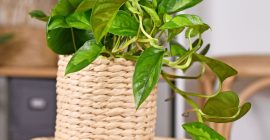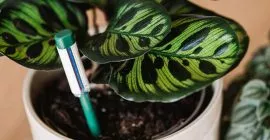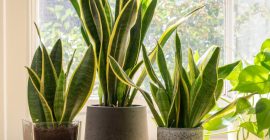Houseplants are the perfect way of bringing nature indoors, adding vibrancy and even a touch of the exotic to our living spaces. Each houseplant has its own unique origin, adapting to various climates and conditions in its native habitat. Understanding where these plants come from can enhance our appreciation of their unique needs and beauty. Let’s take a look at where some of the UK’s most popular houseplants originate from!
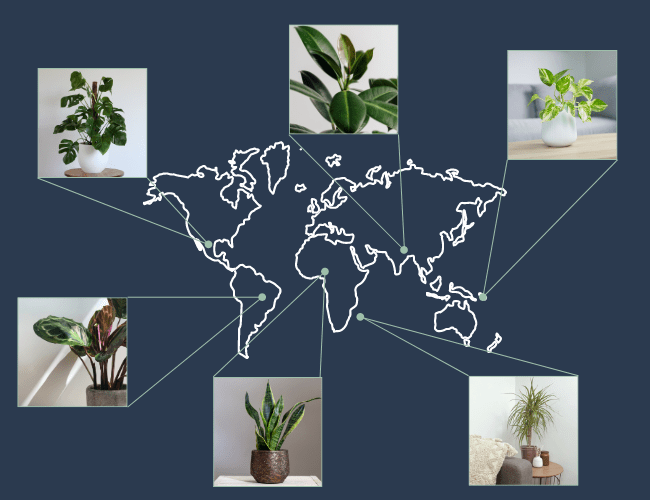
Swiss Cheese Plant (Monstera Deliciosa)
Origin: Central & South America
The Swiss Cheese Plant, known for its distinctive split leaves, originates from the tropical rainforests of Central and South America. Native to countries such as Mexico, Panama, and Colombia, this plant thrives in humid environments with indirect sunlight.
Ideal location in the house for a Swiss Cheese Plant: By a west- or east-facing window, or in a bright room away from the window. Direct sun can scorch the leaves of this beautiful plant.
Rubber Plant (Ficus Elastica)
Origin: Southeast Asia
The Rubber Plant, is native to the tropical regions of Southeast Asia, including India, Nepal, Myanmar, China, Malaysia, and Indonesia. It thrives in warm, humid conditions, which makes it well-suited to indoor environments.
Ideal location in the house for a Rubber Plant: These plants love bright, sunny spots, but need indirect sunlight as it can burn their leaves. Perhaps near a door with glass panes that has access to sunlight.
Pothos (Epipremnum Aureum)
Origin: Solomon Islands
Pothos, also known as Devil’s Ivy, originates from the Solomon Islands, a group of islands in the Pacific Ocean. Its hardy nature and ability to thrive in low-light conditions make it a popular choice for indoor gardening.
Ideal location in the house for a Pothos: These houseplants are quite versatile in the way in which they can tolerate medium to low light, but thrive in bright, indirect light. We recommend placing in an east- or west- facing window.
Dragon Tree (Dracaena Marginata)
Origin: Madagascar
The Dragon Tree, is native to the island of Madagascar. It is characterized by its slender, arching leaves and is prized for its resilience and striking appearance.
Ideal location in the house for a Dragon Tree: Place your Dragon Tree in bright, indirect sunlight, with an average temperature of 18-24ºC. If exposed to direct sunlight, the leaves of this plant are at risk of scorching. You could grow them in a bathroom or kitchen to provide them with humidity.
Snake Plant (Sansevieria Trifasciata)
Origin: West Africa
The Snake Plant, or Mother-in-Law’s Tongue, is native to the tropical regions of West Africa, particularly Nigeria and Congo. It is renowned for its ability to tolerate low light and infrequent watering, making it an ideal plant for beginners.
Ideal location in the house for a Snake Plant: Too much direct sunlight can burn this houseplant, but a few hours of early-morning direct sunlight is suitable for a Snake Plant. For the rest of the day find a bright windowsill that has indirect sunlight.
Calathea (Prayer Plant)
Origin: Tropical Americas
Calatheas are indigenous to the tropical regions of the Americas, with a significant number of species originating from Brazil. They thrive in the understory of tropical rainforests, where they are accustomed to warm temperatures, high humidity, and low light conditions.
Ideal location in the house for a Calathea: Place your Calathea in a bright spot with indirect sunlight. It is well suited to a bathroom environment due to the high humidity and lower light conditions.
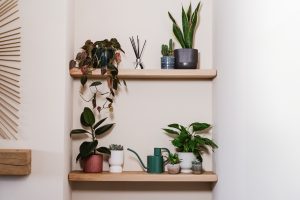
Ensure you water your houseplants sufficiently. To keep on top of their watering habits use a Westland Houseplant Watering Indicator. When this handy device turns red, it’s detecting that your plant’s soil is dry and needs a top up of water.
Learn more about watering your indoor jungle here.
Understanding the origins of houseplants helps us recreate their natural habitats within our homes, ensuring they thrive and bring joy to our living spaces. Each plant’s unique history and native environment influence its care needs and growth habits. By embracing this knowledge, we can become better gardeners and foster a deeper connection with the natural world, right from our living rooms.


